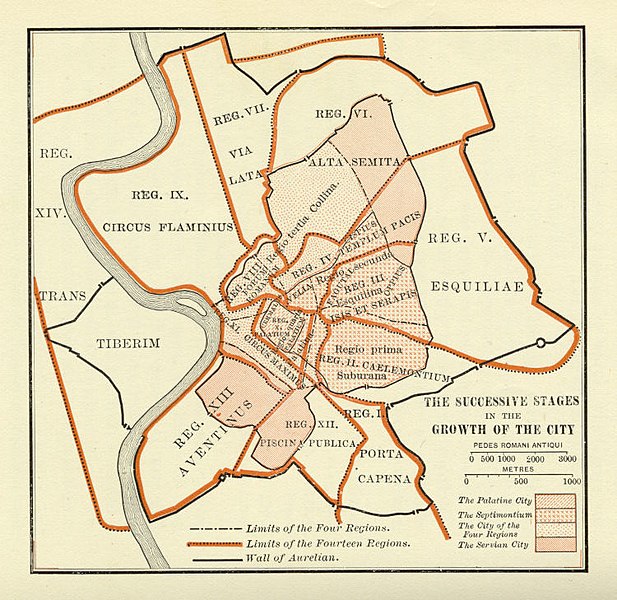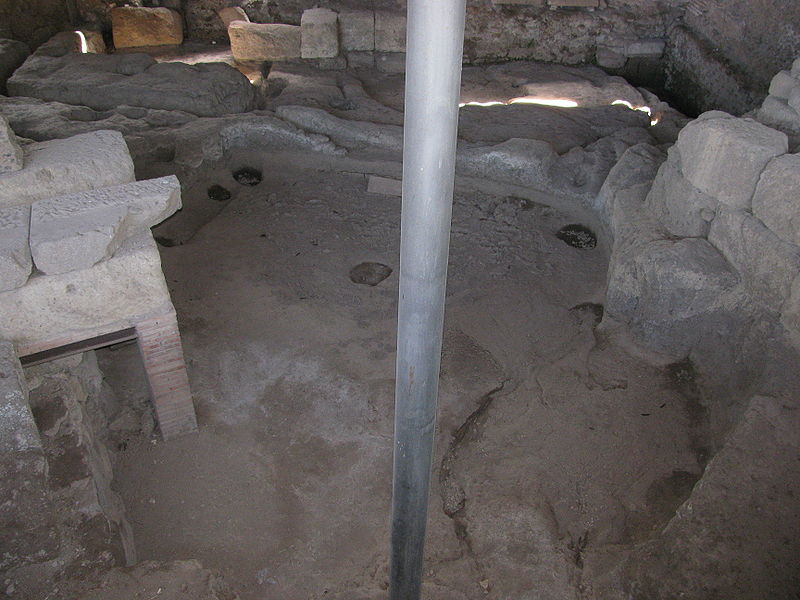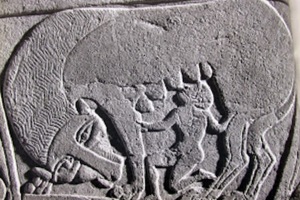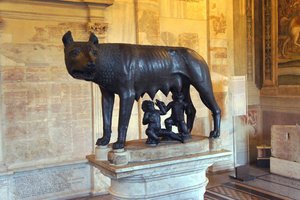Royal Rome
The most ancient and least known period in the history of Ancient Rome formally lasted from 753 BCE (the founding of Rome) until the overthrow of the last king, Tarquin the Proud, and the establishment of the Republic in 509 BCE. Many legends exist about the origin of the city.
When studying the Royal period, the following main themes are usually considered:
- The earliest cultures in Italy
- The founding and development of Rome
- Roman Kings
- Patricians and Plebeians
The climate of the Apennine Peninsula is favorable for life and was even milder in ancient times, lacking the exhausting heat of today. The Italics appeared on the peninsula around the turn of the 3rd and 2nd millennia BCE, migrating in two waves from the northeast. By "Italics," we understand more than 20 tribes inhabiting this area, including the Latins, Etruscans, Samnites, etc. The Latins, who settled in Latium, played a particularly significant role in history. The history of Rome is essentially the history of the Latins. Rome emerged on the Tiber River, 25 km from the Tyrrhenian Sea. As noted by the renowned classicist S.I. Kovalev, the small tribe of Latins occupied the northern part of Latium, known as Ancient Latium. It lay between two wealthy regions, Etruria and Campania, inhabited by cultured and trading tribes. Latium itself was a hilly plain along the lower Tiber, covering about 1.5 thousand square kilometers. Its borders were the sea, the Tiber, the Aniene (a tributary of the Tiber), the Sabine hills, and further on, the mountainous areas of the Aequians, Hernicians, and Volscians. The center of Latium was the Alban Hills. Due to its volcanic origin, the soil in Latium was rich in minerals and thus suitable for agriculture.
 Plan of the City - Rome
Plan of the City - Rome
The Legend of Rome's Founding
After the fall of Troy, the Trojans, led by Aeneas, arrived in Latium, where they were welcomed by King Latinus. Aeneas married Latinus' daughter, Lavinia. Upon Latinus' death, Aeneas became king of the Latins and Trojans. Aeneas' son, Ascanius (also known as Iulus), founded the city of Alba Longa after his father's death and became its king. Later, Numitor ruled here but was overthrown by his older brother, Amulius. Amulius made Numitor's daughter, Rhea Silvia, a Vestal Virgin, who were bound by a vow of chastity, breaking which led to being buried alive. Rhea Silvia, however, bore twin sons, Romulus and Remus, by the god Mars. Amulius ordered them to be cast into the Tiber, but they survived, washed ashore, and were suckled by a she-wolf. Later, a shepherd found them, and they lived with him until they reached adulthood. Upon discovering their royal lineage, Romulus and Remus avenged Amulius and restored their grandfather. Soon, they founded a new city, named Rome (Roma) after Romulus. A quarrel arose between the brothers, resulting in Romulus killing Remus and naming the city after himself.
This version of the legend can be seen in the works of Plutarch, Dionysius of Halicarnassus, and Titus Livy. The legend lacks historical accuracy. According to M.V. Belkin, the legend consists of two layers: one, a myth common among many peoples about the mysterious origin and miraculous survival of a hero suckled by an animal, and two, folklore motifs explaining the origin of the city's name, hills, and various rituals. Likely, one hero was initially the city's founder, with the doubling of the hero occurring when the two layers combined into one legend. This resulted in the legend of the twins, Romulus and Remus. In the legend's end, one hero had to die (Remus) since the Romans believed that both the eponym and bearer of royal power could only be one person. Archaeological data supports this: an Etruscan tombstone from the 5th century BCE depicts a she-wolf suckling one child. The well-known bronze sculpture, the Capitoline Wolf, now in the Capitoline Museums in Rome, shows two infants; however, the statues of Romulus and Remus were added in the 16th century, likely by Antonio del Pollaiuolo. Therefore, the version of the two twins emerged later. According to S.I. Kovalev, the legend gained official recognition in the 1st century CE to assert the divine origin of the Julian family, from which the first dynasty of Roman emperors came. This explains the significant role of Ascanius-Iulus in the legend.
Early Settlements in Latium
Rome is often referred to as "the city on seven hills." Indeed, the city is now located on seven hills (Palatine, Capitoline, Quirinal, Viminal, Caelian, Aventine, and Esquiline). But was it always this way? According to ancient tradition, the city's founding dates to 754/753 BCE. Archaeological excavations have shown that settlements existed here in the 9th-8th centuries BCE, but these settlements did not yet constitute a full-fledged city. The first settlements appeared on the Palatine, followed by the Capitoline and Quirinal hills, and later the remaining four hills were settled. It was only from the 7th century BCE that the lowlands between the hills began to be gradually settled, temples were built, the city center (Forum) was formed, and by the 6th century BCE, the city was encircled by a wall. Archaeological data indicates that these were settlements of different tribes. The Palatine and part of the Caelian belonged to the Latins, while the northern hills were inhabited by the Sabines. Thus, Roman society was multi-tribal. The tradition of Romulus reflects the desire to unite different tribes into a city. For example, Titus Livy in his famous work "History of Rome from its Foundation" describes Romulus' abduction of the Sabine women and the unification of the Roman and Sabine states. According to Livy, shortly after the city's founding, many Romans lacked wives, and neighboring tribes refused to marry their daughters to them. Romulus then resorted to a ruse and invited the neighboring Sabines to a festival. The Sabines came with their families, and during the festivities, the Romans unexpectedly attacked and abducted the young women. Outraged, the Sabines went to war with the Romans, but the abducted daughters, having become attached to their new husbands, reconciled them with their Sabine relatives. Thus, according to the legend, the two states merged into one, with Romulus and the Sabine king, Titus Tatius, ruling together until Tatius' death. This tale of unification lacks consensus in modern historiography regarding the timing of the merger of Roman and Sabine tribes.

The Kings of Rome
According to tradition, the regal period in Rome lasted 244 years, from 753 BCE to 509 BCE, during which seven kings ruled:
1) Romulus
2) Numa Pompilius
3) Tullus Hostilius
4) Ancus Marcius
5) Tarquinius Priscus
7) Tarquinius the Proud
The reigns of the first two kings were most significant for the development of the Roman community. Romulus is credited with creating the entire social and military structure: dividing Romans into thirty curiae, establishing three tribes, creating an asylum for fugitives, and forming a senate of 100 men. He also divided the population into patricians and plebeians and formed infantry and cavalry.
The second king, Numa Pompilius, laid the foundations of religious and economic life. During his reign, the major priestly colleges were established, the calendar was created, and many temples were built, the most famous being the Temple of Janus.
The third and fourth kings, Tullus Hostilius and Ancus Marcius, displayed moments of duplication of Romulus and Numa. Tullus Hostilius was warlike, destroyed Alba Longa, and relocated its inhabitants to Rome. He built the senate house, later called the Curia Hostilia, considered very ancient. Ancus Marcius likely focused on expanding Rome's territory towards the Etruscan coast of the Tiber.
Starting with the fifth king, Tarquinius Priscus, the Etruscans gained power in Rome, either through military conquest or gradual peaceful penetration. It is undisputed that Rome was under Etruscan rule for about a century, significantly influencing various aspects of Roman life. According to legend, from Tarquinius Priscus onward, there was a gradual strengthening of royal power, attempts to disrupt the election procedure, and perhaps make the kingship hereditary.
The sixth king, Servius Tullius, is credited with several significant reforms.
The last king, Tarquinius Superbus, is depicted as a tyrant, expelling the best citizens and making arbitrary decisions without consulting the people or the senate. The tradition claims he was overthrown, and the arbitrary seizure of power became dangerous. This led to the prohibition of kings in Rome, replaced by two annually elected consuls, with the real power transferred to the senate. This marked the beginning of the Roman Republic.
 Page with Images of Roman Kings from the Book by Totti Pompilio "Portrait of Ancient Rome", 1633
Page with Images of Roman Kings from the Book by Totti Pompilio "Portrait of Ancient Rome", 1633
Roman Community in the Era of Kings
The foundation of the community was the clan. Clans united into curiae, and curiae into tribes. Tradition counts 3 tribal tribes (Tities, Ramnes, and Luceres), 30 curiae, and 300 clans (the same number as senators). Almost everyone belonged to a specific clan. All clan members were united by a common clan name (nomen) and collective ownership of land. Additionally, the clan had common religious festivals and burial grounds. Each clan was divided into families, headed by the family patriarch (pater familia). The father's power in that era was almost unlimited. Nemirovsky A.A. in his work "History of the Ancient World: East, Greece, Rome" writes that members of the clan (gentile) organization constituted the Roman people of the Quirites (populus Romanus).
Clients (translated from Latin as obedient, dependent) were Roman citizens who, for various reasons, sought the patronage of an influential and wealthy person who became their patron. Both the patron and the client had a number of obligations to each other. The client had to perform various tasks for the patron, such as accompanying him on campaigns or lending money. The patron, in turn, could allocate land, livestock, defend in court, and teach law to the client.
Patricians and Plebeians
Patricians and Plebeians are the two oldest estates of the Roman state, which appeared in the royal period and lasted for many centuries. Let's examine the functions and rights of each separately.
Patricians – from pater (Latin for father):
- Enjoyed the full range of civil rights
- Voted in the curiate assemblies
- Were elected to the Senate
- Served in the cavalry and heavy infantry
- Held major magistrate positions (in the royal period)
- Could be elected to priestly colleges (in the royal period)
Plebeians – from pleo (Latin for mass, multitude):
- Legally free unlike slaves and clients
- Deprived of civil rights
- Could be admitted into patrician clans as clients
The issue of the origin of patricians and plebeians is one of the most controversial in historiography. It includes two aspects: firstly, it is unclear on what principle the division was based. Secondly, the timing of the formation of these estates is disputed.
Theories on the Origin of Patricians and Plebeians
1. B.G. Niebuhr's Theory: Patricians are the indigenous full citizens of Rome, and plebeians are the incoming or conquered population. Patricians are indigenous and have a clan organization, thus having civil rights. Plebeians are newcomers and have neither.
2. E. Meyer's Economic Theory: Patricians are the wealthy, and plebeians are the poor, or patricians are large landowners, and plebeians are dependent farmers.
3. E. Zellner's Ethnic Theory: Patricians are one ethnic group, and plebeians another. This was rejected.
4. Fustel de Coulanges' Ethno-Religious Theory: Patricians and plebeians had different cults and gods. The possible criterion for division is social and economic differences. According to this theory, patricians and plebeians are ethnically homogeneous and indigenous citizens of Rome.
5. S.I. Kovalev's Complex Theory: The reason for the division is ethnic, migratory, and economic factors.
A significant factor in social relations in the Roman community was clientela or patronage. Clientela was known to many peoples and was hereditary in Rome.
Political System under the Kings
In royal Rome, there were three branches of power: the popular assembly (curiate assemblies), the council of elders (senate), and officials. At the head of the state was the king (rex). He performed the functions of commander, high priest, and judge of the community. His power was not hereditary, i.e., it was not passed from father to son. Therefore, there was a scheme for electing a new king, consisting of three stages:
1. Interregnum - the period between reigns, announced after the king's death. During this time, the Senate (senatus) selected a new candidate for the throne.
2. Approval of the chosen candidate by the popular assembly (comitia curiata).
3. Inauguration (inauguratio) - a solemn inquiry by augurs (priests) into the will of the gods. This is the origin of the tradition of presidential inauguration. After this, presumably, the chosen king was approved by the Senate and given the imperium.
Senatus (Senate) - a deliberative body advising the king. It had real power during the interregnum, as major state issues were decided solely by the king. Initially, the senate consisted presumably of 100 senators, a creation traditionally attributed to Romulus. Later, in the royal era, it was expanded to 300 members.
Comitia Curiata (Popular Assembly) - assemblies of the people by curiae. Convened by the king to approve various state matters. It had real power, like the senate, during the interregnum.
Related topics
Rome, Roman Republic, Roman Empire, Senate, Plebeians, The Patricians
Literature
1. Belkin M. V., Verzhbitsky K. V. Istoriya Drevnego Rima [History of Ancient Rome]. Training manual. 2nd ed., ispr. and add. - St. Petersburg: SPbU, 2007. - 197 p.
2. Dionysius of Halicarnassus. Roman Antiquities in 3 volumes. T1, Moscow: Rubezhi XXI Publ., 2005, 278 p.
3. History of the ancient world. East, Greece, Rome. textbook / I. A. Ladynin [et al.]. - Moscow.: Word.Eksmo Publ., 2004, 575 p. (in Russian)
4. Kovalev S. I. Istoriya Rima [History of Rome]. New edition, revised and expanded/Ed. by Prof. E. D. Frolov, St. Petersburg: Polygon Publ., 2002, 864 p.
5. Mashkin N. A. Istoriya Drevnego Rima [History of Ancient Rome], Moscow: Vysshaya shkola Publ., 2006, 753 p.
6. Meyer E. Ekonomicheskoe razvitie v Drevnogo mire [Economic Development in the Modern World]. Moscow:. Mir Publ., 1910, 108 p. (in Russian)
7. Plutarch. Comparative biographies in 2 volumes.T1. Moscow: Nauka Publ., 1961. -503 p.
8. Titus Livy. The history of Rome from the foundation of the city. [electronic resource]. URL: http://ancientrome.ru/antlitr/t.htm?a=1364000100 (accessed 15.01.2017).
9. Fustel de Coulange N. D. Drevnyaya grazhdanskaya obshchina [The ancient Civil community], Translated from French by N. N. Spiridonova, 2nd ed. Moscow: 1903, 459 p.
10. Zeller M. Roman state and legal antiquities: A Compendium for gymnasium students and teachers. Moscow:. 2019. - 308 p.




